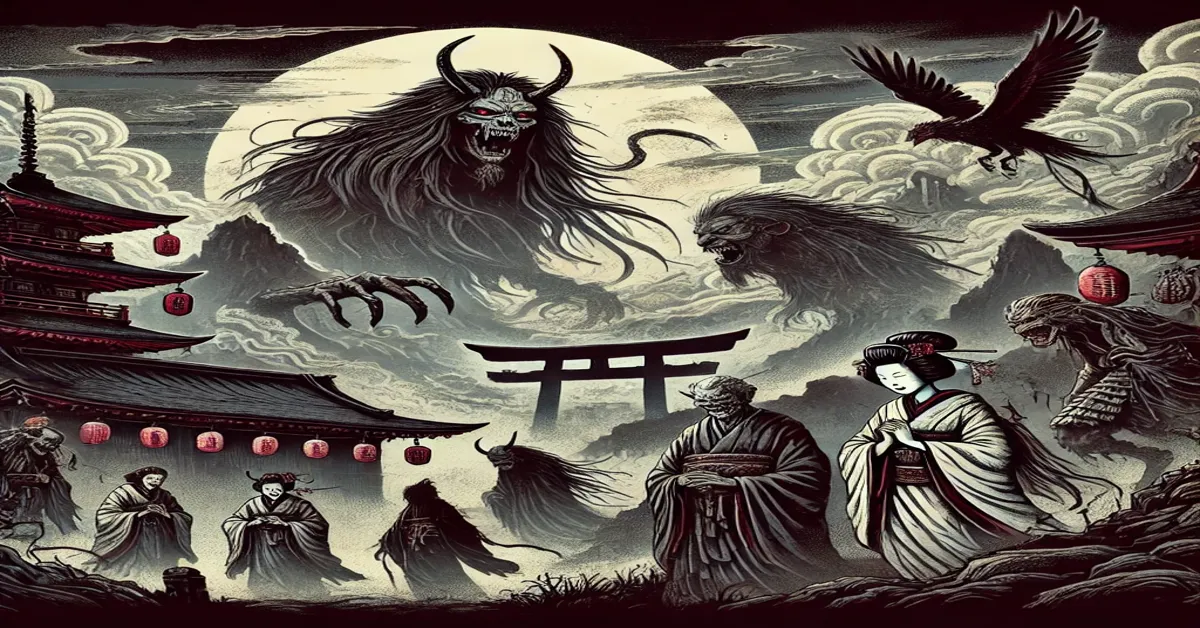Japan’s mythology and folklore are rich with characters and entities that embody both light and darkness. While much attention is given to the honorable heroes and deities that guide and protect, an equally fascinating, albeit darker, realm exists where malevolent forces reside. These evil characters are often personifications of fear, chaos, and death, created japanese evil names and meanings to explain natural disasters, personal tragedies, and the darker aspects of human nature.
In this article, we’ll explore some of the most infamous Japanese evil names and their meanings, providing insight into how these figures have shaped Japanese culture, art, and tradition.
1. Oni (鬼)
1.1 Meaning and Origin (japanese evil names and meanings)
The word “Oni” translates to “demon” or “ogre” in English. Oni are traditional demons or evil spirits in Japanese folklore. These creatures are typically depicted as hulking figures with sharp horns, grotesque features, and colored skin—most commonly red or blue.
1.2 Role in Folklore
Oni are known for being malevolent beings that bring disaster, disease, and death. They are often portrayed in folktales as enemies of humanity. However, some Oni have also been depicted in protective roles, guarding temples or punishing sinners japanese evil names and meanings in the afterlife, blurring the lines between pure evil and morality.
1.3 Modern Usage
In contemporary Japan, Oni are symbols of fear and evil but are also invoked during festivals such as Setsubun, where people throw beans to drive them away, symbolically cleansing evil spirits from their homes.
2. Yurei (幽霊)
2.1 Meaning and Origin
“Yurei” refers to vengeful spirits or ghosts in Japanese mythology. The term translates directly to “faint spirit,” indicating its ghostly nature. These entities are similar to Western ghosts, often representing someone who has died with strong emotional turmoil, japanese evil names and meanings especially as a result of murder, betrayal, or an unfulfilled task.
2.2 Role in Folklore
Yurei spirits often return from the dead to haunt the living. Unlike ordinary spirits, who pass on peacefully, Yurei are tied to the physical world by unresolved emotions. They are usually depicted as women with long, black hair, white funeral clothing, and a pale, ethereal appearance.
2.3 Famous Yurei
The most famous Yurei stories are found in Kabuki theater, with “The Ghost of Oiwa” from Yotsuya Kaidan being a particularly chilling tale of revenge. Yurei embody the idea that unresolved human emotions, particularly vengeance, can cross the boundary japanese evil names and meanings between life and death.
3. Shuten-dōji (酒呑童子)
3.1 Meaning and Origin
Shuten-dōji, whose name translates to “Drunken Boy,” is one of Japan’s most feared demons from the Heian period. He is depicted as a giant with an japanese evil names and meanings insatiable thirst for alcohol and human flesh.
3.2 Role in Folklore
Shuten-dōji was a notorious Oni leader who terrorized Kyoto by abducting young women, eating them, and drinking their blood. According to legend, he was eventually defeated by the samurai Minamoto no Yorimitsu, who disguised himself and his warriors as traveling monks to infiltrate the demon’s lair.
3.3 Symbolism
Shuten-dōji represents unrestrained desires and indulgence in the darker aspects of humanity—alcohol, gluttony, and violence. His story is often a cautionary tale about the dangers of overindulgence and unchecked evil.
4. Jikininki (食人鬼)
4.1 Meaning and Origin
The term “Jikininki” means “human-eating ghosts.” These malevolent spirits are found in Japanese Buddhist traditions, representing the souls of greedy, selfish individuals who are cursed after death.
4.2 Role in Folklore
Jikininki feed on the corpses of the dead, and their appearance is grotesque, often described as decomposing, with bloated faces and discolored skin. Unlike Yurei, Jikininki do not return for personal revenge but are cursed to consume the dead as a japanese evil names and meanings punishment for their greed in life.
4.3 Moral Lessons
The concept of Jikininki highlights the importance of generosity and compassion in Buddhist teachings. Their eternal curse to feed on the dead represents the destructive nature of greed and selfishness, serving as a reminder of the consequences of immoral behavior.
5. Tengu (天狗)
5.1 Meaning and Origin
Tengu, meaning “heavenly dog,” is a type of evil or mischievous spirit in Japanese folklore. They are bird-like creatures, often depicted with human and avian features, including wings and long noses. While some Tengu are considered protectors of the mountains, others are seen as malicious beings that enjoy leading people astray.
5.2 Role in Folklore
Tengu are notorious tricksters, known for kidnapping monks, disrupting religious practices, and sowing chaos. Some legends even suggest that they trained japanese evil names and meanings skilled warriors in the art of combat, further adding to their ambiguous nature between good and evil.
5.3 Symbolism
Tengu represent the dangers of arrogance and pride, particularly in religious contexts. Their trickster behavior warns against taking oneself too seriously, especially in spiritual matters.
6. Yuki-onna (雪女)
6.1 Meaning and Origin
Yuki-onna, or “snow woman,” is a ghostly figure who appears in snowstorms. Her name directly translates to “snow woman,” and she is often depicted as a beautiful, ethereal figure dressed in white, with pale skin as cold as ice.
6.2 Role in Folklore
Yuki-onna is said to lure travelers into snowstorms, freezing them to death with her icy breath. In some stories, she is compassionate and spares her victims, but in others, she is merciless and kills without hesitation. Her icy beauty and deadly nature make her one of the most memorable evil spirits in Japanese folklore.
6.3 Representation of Nature
Yuki-onna is often seen as a personification of the deadly power of nature, particularly in winter. She embodies the beauty and danger of the snowy mountains, japanese evil names and meanings teaching respect for nature’s unforgiving forces.
7. Rokurokubi (ろくろ首)
7.1 Meaning and Origin
Rokurokubi are a type of yokai (supernatural creature) known for their ability to stretch their necks to extraordinary lengths. The name “Rokurokubi” translates to “pulley neck,” referencing the unnaturally long necks they develop during nighttime.
7.2 Role in Folklore
During the day, Rokurokubi appear as ordinary human women. However, at night, their heads stretch out and wander around, often spying on or scaring people. In some stories, japanese evil names and meanings they suck the life force from humans or animals.
7.3 Symbolism
Rokurokubi are often interpreted as symbols of deceit or hidden evil. Their ability to appear normal during the day but reveal their true nature at night reflects the duality of human behavior, where darkness and hidden malice are concealed under normal appearances.
8. Gashadokuro (がしゃどくろ)
8.1 Meaning and Origin
Gashadokuro, meaning “starving skeleton,” is a giant skeletal figure in Japanese folklore. These terrifying creatures are said to be the spirits of people who died japanese evil names and meanings from starvation or in battle and were not given a proper burial.
8.2 Role in Folklore
Gashadokuro are enormous, towering skeletons that roam the countryside, attacking and devouring humans. Their presence is often foreshadowed by the sound of rattling bones. Gashadokuro are invincible and can only be dispelled through religious rituals.
8.3 Representation of War and Famine
Gashadokuro represents the horrors of war and famine, symbolizing the restless spirits of those who died violently or in extreme suffering. They serve as reminders japanese evil names and meanings of the consequences of societal neglect and the chaos brought by war.
9. Ushi-oni (牛鬼)
9.1 Meaning and Origin
Ushi-oni translates to “ox demon.” These creatures are typically depicted as having the body of a spider or crab and the head of a bull. Ushi-oni are water-dwelling yokai that attack and devour humans.
9.2 Role in Folklore
Ushi-oni live near coastal areas and rivers, where they ambush unsuspecting travelers. Some legends describe them as bloodthirsty monsters, while others give them a more protective role, suggesting they are guardians of sacred sites.
9.3 Symbolism
Ushi-oni represents the untamed, primal forces of nature, particularly water. Their appearance in folklore warns of the dangers lurking in the wild and the unpredictability japanese evil names and meanings of nature’s wrath.
10. Yomotsu-shikome (黄泉醜女)
10.1 Meaning and Origin
Yomotsu-shikome are hideous women from the underworld (Yomi), the Japanese land of the dead. The term translates to “ugly women of Yomi,” and they japanese evil names and meanings are tasked with hunting down those who try to escape the afterlife.
10.2 Role in Folklore
According to the myth of Izanagi and Izanami, the creation deities of Japan, Izanami, after dying, became a ruler of Yomi
. When her husband Izanagi attempted to bring her back to life, he saw her decayed and horrific form, prompting her to send the Yomotsu-shikome after him to drag him back to Yomi.
10.3 Symbolism
Yomotsu-shikome symbolizes the inevitability of death and the futility of escaping fate. Their grotesque appearance also represents the fear of decay and the japanese evil names and meanings unchangeable nature of death.
Conclusion
Japanese evil names and the characters they represent serve to embody the darker aspects of life, whether they represent natural disasters, war, death, japanese evil names and meanings or personal vices. While terrifying, they also reflect important cultural values, acting as moral lessons or warnings against indulgence, greed, and unchecked pride. These figures continue to be prominent in Japanese art, literature, and even modern media, keeping the myths alive.
FAQs
- What are Oni in Japanese folklore? Oni are demons or ogres in Japanese folklore, often depicted as large, fearsome creatures that bring disaster and death. They symbolize evil but sometimes take on protective roles.
- What is the significance of Yurei in Japanese culture? Yurei are vengeful spirits that represent unresolved emotions after death, such as revenge or grief. They are often portrayed in folklore as ghosts who haunt the living.
- Who is Shuten-dōji? Shuten-dōji is a legendary Oni from Japanese folklore known for his immense strength, alcoholism, and cannibalistic behavior. He was ultimately defeated by the samurai Minamoto no Yorimitsu.
- What does Gashadokuro symbolize? Gashadokuro, the giant skeleton, symbolizes the horrors of war and famine. It is the embodiment of restless spirits japanese evil names and meanings who died violently or from starvation.
- What is the role of Yuki-onna in Japanese folklore? Yuki-onna, or “snow woman,” is a ghostly figure who lures travelers to their deaths in snowstorms. She symbolizes both the beauty and danger of winter.
- What are Tengu, and how are they depicted? Tengu are mischievous, bird-like spirits in Japanese folklore known for causing trouble and leading japanese evil names and meanings people astray. They symbolize pride and arrogance.











